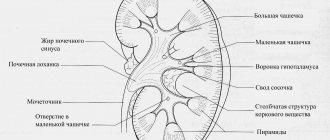Features of yoga practice
The kidneys are responsible for the reproductive function of the body, the movement of fluid in the human body, hematopoiesis, brain development and bone strength, hair growth and hearing. Medical studies show that the right kidney in women controls the pregnancy process and the monthly cycle, and in men the production of sperm and their quality. The left kidney stores hereditary memory and controls the manifestation of hereditary diseases of the renal and genitourinary systems.
When kidney function is impaired, a person experiences some abnormalities in brain function, insomnia, dizziness, a feeling of constant overwork, ringing and noise in the ears, nagging pain in the lumbar region, partial baldness, problems with dental health, a sharp deterioration in memory and the thought process itself. Therefore, even in the initial stages of illness, it is important to do everything possible in time to regain lost health.
Experts who have been studying yogic science for years agree that it is possible to practice yoga even if you have abnormalities in the functioning of the renal system. When starting practice, it is important to exclude the occurrence of an inflammatory process. If it is diagnosed, yoga classes for acute kidney disease should be stopped for a while. Yoga for the kidneys and bladder is based on the regular alternation of certain body poses. For these ailments, it is recommended to alternate:
- concave poses - in which active absorption of blood into organs and tissues occurs;
- arched poses – which are characterized by squeezing blood from tissues and organs.
After alternating these body positions, you should engage in leisurely bending to the sides, which helps improve the blood supply to the kidneys.
It is important to note that yoga classes with severe kidney prolapse can be carried out by the patient after complex therapy has been completed and excluding a possible period of acute exacerbation. Before starting the practice, it is recommended to take a full course to cleanse these organs of sand and stones.
How does therapeutic yoga work for kidney diseases?
The essence of the healing effect of yoga for kidney diseases lies in the alternation of convex and concave body positions. In a concave position, blood is “sucked out” from the tissues, and in a curved position, on the contrary, it is “squeezed out.” This results in a kind of “sponge effect”.
If you perform lateral extensions after bending and bending, the blood supply to the kidneys significantly improves.
Regularity of performing the asana complex is important. To achieve a therapeutic effect, you should exercise for 15-20 minutes twice a day, without skipping.
Recommended set of exercises
Before starting to perform asanas for kidney treatment, it is recommended to lie on your back for a while and relax your muscles. If there is any discomfort, fatigue or pain, the session should be rescheduled for another time. To practice yoga for kidney stones, it is recommended to purchase a special device: a bolster. This is the name given to a small roller that helps relieve excessive stress on the back and abdominal organs.
Yoga for prolapsed kidneys involves the same set of exercises as for other kidney diseases. This disease is treated with the use of specially designed corsets that promote the correct position of the organs of the renal system. Strong physical activity during kidney prolapse is not recommended; yogic practice is the best choice for patients with this disease.
Practice for the kidneys and adrenal glands includes the following set of tasks:
- Temporarily extinguishing star pose or Baddha Konasana. To perform yoga asanas for the kidneys and adrenal glands, take a sitting position on a flat horizontal surface. Legs should be bent at the knees, feet touching each other lightly. Take a deep breath and, as you exhale, bend toward your feet. Hold your feet with your hands. Keep your knees touching the floor as much as possible, which helps stretch your calf muscles. Stay in this position for at least 20 minutes, then straighten up and completely relax.
- Yoga for kidney disease involves regularly performing the martial bow pose or Dhanurasana. This asana has a stimulating effect on the functioning of the lower abdominal organs and helps improve digestion. Starting position: lying on your stomach. Grasp your raised and slightly bent legs with your hands. Stretch your neck and look at the ceiling with your eyes. In order for the asana to have the most effective effect, it is recommended to sway in this position, leaning forward and backward.
- If a practitioner has kidney stones, he should pay attention to the flexible creeping snake pose or Bhujangasana. By regularly performing this asana, sand and stones begin to come out of the kidneys. To perform it, lie on your stomach with your palms at your chest, pointing down. The practitioner takes in a full chest of air, lifting it upward. The body should bend well in the lumbar region, the head should reach towards the ceiling. It is recommended to hold your breath for about a quarter of a minute, and exhale to slowly return your body to its starting position.
- Yoga for the kidneys includes strong staff pose. The practitioner assumes a sitting position with his feet brought together. You need to take a deep breath and lean forward strongly. You should bend not in the lumbar region, but in the pelvic region. Stay in this position for 30 seconds, then take the starting position.
- Arched Staff Pose. Lie on your back, with your hands at the level of the practitioner's head. Take a deep breath and lift your torso up as much as possible, supporting yourself with your arms and legs. The head should touch a horizontal surface. Hold this position for a minute. Then return the body to the starting position.
- To perform the following yoga position for treating kidneys, you will need a bolster. Take a sitting position so that the tight bolster rests against the practitioner’s sacrum. Bend your legs and bring your feet together. It is very important to be able to move your legs as close to your pelvis as possible. Then slowly lower yourself onto the bolster, without lifting your pelvis from the horizontal surface.
- A pose called Uddiyana Bandha or abdominal lifting is considered effective. This task must be performed without sudden hasty movements. Starting position: standing, feet placed approximately shoulder-width apart from the practitioner. Take a deep breath, raise your arms up towards the sun. You need to exhale slowly, trying to completely get rid of the air in your lungs. As you exhale, slowly lower your hands to your hips. Pause after exhaling. Pull your stomach in towards your spine as much as possible, lower your head towards your chest. Straighten your neck and slowly inhale again. Repeat the asana several times.
- Yoga pose for kidney disease: bent plow. To perform it, lie on your back on a gymnastics mat. As you inhale, raise your legs and slowly lower them over your shoulders. Lie down for about 15 seconds, then exhale and lower your feet to the mat.
Exercising with urolithiasis
If a person is diagnosed with a large kidney stone, he needs to stop playing sports.
Sports activity in the presence of the disease is safe only in the early stages of stone formation. If a crystal no larger than 1 mm is present in the body, then physical education will have a positive effect on health. If the stone is large, then exercises can cause it to move, causing it to get stuck in the ureter. This process will be accompanied by hellish pain and aggravation of the patient’s general condition.
Attention! Physical activity is realistic only in cases of a radical way to get rid of the problem.
It should be noted that absolutely all types of people, even professional athletes, are susceptible to urolithiasis. In people with an active lifestyle, stones can form due to the following factors:
- When you exercise, a large amount of water is removed from the body through the sweat glands. Urinary secretions become more concentrated, acquiring large amounts of salt. If you don't drink a lot of liquid, all the sand will begin to crystallize.
- If you overload yourself with physical activity, this can lead to disruption of metabolic processes in the body. In this case, destabilization of blood flow is observed.
- Consuming large amounts of protein, sports supplements, protein, and mineral water negatively affects kidney health.
Scientists conducted studies that showed that every fifth citizen who is actively involved in sports has a normal pH value in urinary secretions. The rest were found to have increased acidity. By the way, a pattern has emerged that team athletes have much better urine than those who engage in individual physical activity.
Attention! For this reason, preventive measures are prescribed on an individual basis, taking into account the characteristics of the sports activity and the type of competition in which the person takes part.
If a person is diagnosed with a large kidney stone, then he needs to stop playing sports. It is especially undesirable to engage in cardio exercises, such as jumping or running. It will be possible to return to sports only after completing the course of therapy, namely, either the fragmentation of the crystal or surgical removal. It is worth noting that even after healing, you should drink the optimal amount of water. Also eliminate protein and protein supplements from your diet. The rehabilitation period should be accompanied exclusively by natural and safe products.
General information about kidney disease
Disturbances in the functioning of the kidneys are most often caused by various diseases; they are inflammatory or infectious in nature, and can be caused by metabolic disorders (KD), blood flow or urine outflow.
Kidney diseases are varied, but if you do not start treating them on time, you can face serious complications. An example is glomerulonephritis.
Kidney disease, which is characterized by inflammation of the glomeruli of the kidneys and a violation of their filtration ability.
The disease is difficult to tolerate and in the absence of adequate therapy can cause severe complications.
If pyelonephritis and glomerulonephritis are diseases of inflammatory origin, they are caused by pathogenic microorganisms. But urolithiasis has nothing to do with inflammatory and infectious processes. KSD develops with metabolic disorders, accumulation of salts in the kidneys and the formation of stones.
The functional capacity of the kidneys also decreases if a person has:
- diabetes mellitus;
- atherosclerosis;
- arterial hypertension;
- diseases of the genital organs.
Often the functioning of organs is affected by their location; they change during pregnancy, as well as during heavy physical exertion, which can lead to the development of nephroptosis or kidney prolapse.
In the treatment of these and many other diseases, exercise therapy is used; such therapy is most effective at the initial stage of disease development.
Therapeutic yoga: contraindications
Before you start practicing therapeutic yoga, it is important to familiarize yourself with the list of contraindications. There are general contraindications for practicing yoga, as well as those that relate to the performance of a specific asana. General contraindications are:
- mental disorders;
- malignant neoplasms;
- severe traumatic brain injury;
- neuroinfections;
- spinal injuries;
- infectious lesions;
- injuries of the musculoskeletal system less than six months ago;
- organic heart lesions (atrial fibrillation, paroxysmal tachycardia, uncompensated defects, myocardial dystrophy, aortic aneurysm);
- postoperative period;
- postpartum period (first three months);
- acute infections;
- blood diseases;
- body temperature is above 37 and below 36.2;
- acute and subacute period of chronic diseases (especially myocardial infarction).
You should be careful with osteochondrosis of the spine and arterial hypertension, severe physical fatigue and constant use of a large number of medications.
In addition, you should not perform asanas on a full stomach (no earlier than 3-4 hours after eating), or take a steam bath in the sauna less than 4 hours before yoga classes or earlier than 6-8 hours after.
Principles of therapeutic exercises
The principle of exercise therapy is to use exercises to restore blood flow to organs and improve urine flow. This will help optimize the functioning of the urinary system.
Training for illnesses
If a person has organ dysfunction, then the following is required:
- eliminate power loads;
- reduce the duration of classes to 35 minutes.
Training is carried out during a period when there is no exacerbation of the underlying disease. Classes should be daily, you can use various exercises, combining them into a complex, so the effectiveness of the training will be higher.
Physical activity
This is a pre-formed set of exercises that is performed daily, preferably 2 times a day: morning and evening.
- normalize your weight (if there are problems);
- strengthen muscle tissue;
- improve kidney function.
Gymnastics, like training, involves tracking indicators: blood pressure levels, pulse. If possible, it is worth keeping a diary; it records your blood pressure, heart rate and weight.
Location and functions of the adrenal glands and kidneys
Every person has two kidneys and two adrenal glands. The adrenal glands are orange triangular tissue 5 cm long, located on the top of the kidneys. Together they look like one continuous organ, although they perform different functions.
Kidney functions
The kidneys play a role in blood circulation and excretion. As part of the blood circulation, the renal structures include the renal arteries and other blood vessels. As part of the excretory system, the kidneys are involved in removing waste from the blood.
Functions of the adrenal glands
The adrenal glands are part of the endocrine system. The endocrine system includes a set of glands in the body that produce hormones.
Hormones produced by the glands include:
1) glucocorticoids - cortisol,
2) mineral corticoids – aldosterone,
3) androgens - testosterone, adrenaline and norepinephrine.
Together, the hormones are involved in regulating blood pressure, stress response, and inflammation. Since the amount of testosterone produced by the adrenal glands is small compared to the testes, the glands do not affect male sexuality.
Contraindications to such therapy
In some cases, it is not worth doing the exercises; it is recommended to avoid gymnastics if:
- there are medical contraindications (check with your doctor in advance);
- feeling unwell;
- suffer from pain in the lumbar region;
- the main disease has entered the acute stage.
Classes should be short, the average duration does not exceed 30-35 minutes, stop the training you have started, it is recommended if:
- there was a sharp pain in the lumbar region or abdominal wall;
- general health has deteriorated significantly;
- blood pressure increased (pain appeared in the head or temporal region).
Moderate training has practically no contraindications, but you should not overload the body; it is better to do it gradually.
Benefit
Many people choose this technique as a “tool” to combat organ pathologies:
- Polycystic disease, kidney prolapse, and a number of adrenal diseases cannot be completely cured by traditional medicine. The search for an alternative leads to yoga, which in most cases gives positive results.
- Normalization of fluids in the body. Some asanas have a diuretic effect, and this is necessary to “flush” the kidneys (in particular, to remove stones).
- In many kidney diseases, intense physical activity is prohibited. Yoga is a practice aimed at finding harmony between the soul, consciousness, and body. The exercises do not require excessive effort, sudden or traumatic movements.
Performing asanas helps to get rid of excess weight, which contributes to the aggravation of kidney diseases.
Exercise sets
Training is carried out only if the disease is not in an exacerbation period. Its main signs are completely absent or weakly expressed. If you conduct classes during an attack, you can only worsen the situation.
For glomerulonephritis
You can start the lesson by performing lunges, then move on to half-squats, while simultaneously clasping your knees with your hands.
Then they begin to perform bends in different directions. They are made with outstretched arms.
Then you can move on to walking in place, while actively making movements with your arms.
Exercise therapy for problems in pregnant women
During pregnancy, preference is given to exercises that improve blood flow to the lumbar region and hind limbs.
Pregnant women are recommended:
- perform bends in different directions;
- jump on a gymnastic ball (if you have one);
- perform leg movements (swings) in a horizontal position.
You can ride an exercise bike or ski; Nordic walking with poles also helps.
It is recommended to perform gymnastics in a horizontal position. But it is better for pregnant women to give preference to those exercises that are performed in an upright position.
You can bend to the sides, but it is better to avoid squats and exercises aimed at training the abdominal muscles.
Performing physical therapy
Patients with urolithiasis can engage in special exercises that are designed for such a diagnosis
Patients with urolithiasis can engage in special exercises that are designed for such a diagnosis. By performing it you can not only get rid of the disease, but also maintain the overall tone of the body. It is necessary to choose a complex only on the recommendation of a medical specialist. Only he can take into account all the nuances of the disease and select the optimal physical activity.
After surgery, it is not recommended to engage in physical exercise, as the load will be on the genitourinary organs. Only after a few days can you start playing sports. It is worth noting that you need to return to your usual load gradually. Exercises during this period will help:
- Positively influence and improve the functioning of the genitourinary organs;
- Get rid of sand and small crystals in systems;
- Bring metabolic processes back to normal.
You should engage in therapeutic physical activity taking into account that when diagnosing urolithiasis, you should include exercises with frequent changes in body position. Every day you need to allocate at least 45 minutes to exercise.
It is worth noting that this time can be divided into two approaches. For example, you can exercise for 20 minutes in the morning and evening. After this, you can go for a massage, thus consolidating the effect of the workout. This approach to therapy will help with the following:
- Peristaltic movement in the intestines improves due to the formation of fluctuations in the level of pressure in the abdominal area. The ureter stretches and contracts, allowing small particles to pass into and out of the bladder.
- The general complex includes movements that contribute to changes in the reflexes of motor-visceral tissues. There is an improvement in smooth muscle in the ureteral fibers.
Such exercises have a positive effect on the development of the abs and core; they contain twisting, sudden changes in body position, jumping rope, running in place and with acceleration, etc. It should be noted that a mandatory requirement for such training is alternating exercises. From all of the above, we can come to the conclusion that it is possible to play sports with kidney stones, but only in the early stages of the disease. In severe cases, it is not recommended to do anything without consulting a doctor.
Yoga for the kidneys
It implies the concept of poses; they are simple and not highly complex. Yoga is useful because through regular training, blood flow to the organs significantly improves.
So, yoga for the kidneys:
- You should sit on the floor, lie on your back, bend your knees, lift your pelvis off the floor, fix the position for a few seconds;
- sit on a chair, straighten your back, raise your legs without bending them at the knees, fix them in a position at an angle of 45 degrees;
- You should get on all fours, rest your knees and elbows on the floor, fix the position for a few minutes, you can stretch your legs one by one.
As a warm-up, it is recommended to sit on the floor and try to reach the toes of your outstretched leg. But at the same time make smooth, not sharp movements, without jerking.
Rules for conducting therapeutic training
Recommendations will concern the exercise regimen to raise the kidneys and general changes in the patient’s physical activity that affect the dynamics of nephroptosis:
- Limit heavy lifting to 2 kg;
- It is useful to supplement gymnastics with walking, swimming and good nutrition (you should not reduce calories without special indications);
- if there are instructions to wear a kidney band, it must be removed during exercise therapy;
- try to avoid sudden jumps, shaking and twisting of the body;
- the optimal interval between meals and exercise is at least 2 hours;
- It is advisable to perform exercises regularly 1-2 times a day for 30 minutes;
- You should practice on the floor, laying down a mat and placing a pillow under your lower back;
- you should pay attention to breathing control;
- If pain or symptoms of atypical fatigue appear, training should be stopped;
- Before performing any exercises, you should consult your doctor.
Helpful information
Therapeutic exercise is part of the main therapy in the treatment of many diseases. Exercises are selected individually. At the initial stage, they are carried out in a group, in a hospital setting.
But after completing the course of treatment in a medical institution, you can continue training at home. Therapy will be more effective if it is supplemented with:
- walking in the fresh air;
- exercises in the pool;
- jogging (with the possibility of colic excluded).
Performance will increase if you combine gymnastics:
- in compliance with the drinking regime;
- with refusal of certain products;
- with limiting the amount of salt consumed;
- avoiding alcohol and drinks with high caffeine content.
Exercising with urolithiasis
If a person is diagnosed with a large kidney stone, then he needs to stop playing sports.
Sports activity in the presence of the disease is safe only in the early stages of stone formation. If a crystal no larger than 1 mm is present in the body, then physical education will have a positive effect on health. If the stone is large, then exercises can cause it to move, causing it to get stuck in the ureter. This process will be accompanied by hellish pain and aggravation of the patient’s general condition.
Recommended reading:
Causes of urate formation in urine in children and pregnant women
Attention! Physical activity is realistic only in cases of a radical way to get rid of the problem.
It should be noted that absolutely all types of people, even professional athletes, are susceptible to urolithiasis. In people with an active lifestyle, stones can form due to the following factors:
- When you exercise, a large amount of water is removed from the body through the sweat glands. Urinary secretions become more concentrated, acquiring large amounts of salt. If you don't drink a lot of liquid, all the sand will begin to crystallize.
- If you overload yourself with physical activity, this can lead to disruption of metabolic processes in the body. In this case, destabilization of blood flow is observed.
- Consuming large amounts of protein, sports supplements, protein, and mineral water negatively affects kidney health.
Scientists conducted studies that showed that every fifth citizen who is actively involved in sports has a normal pH value in urinary secretions. The rest were found to have increased acidity. By the way, a pattern has emerged that team athletes have much better urine than those who engage in individual physical activity.
Attention! For this reason, preventive measures are prescribed on an individual basis, taking into account the characteristics of the sports activity and the type of competition in which the person takes part.
If a person is diagnosed with a large kidney stone, then he needs to stop playing sports. It is especially undesirable to engage in cardio exercises, such as jumping or running. It will be possible to return to sports only after completing the course of therapy, namely, either the fragmentation of the crystal or surgical removal. It is worth noting that even after healing, you should drink the optimal amount of water. Also eliminate protein and protein supplements from your diet. The rehabilitation period should be accompanied exclusively by natural and safe products.











